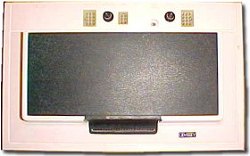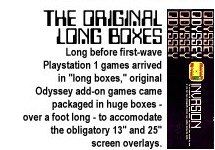An electronic game of thought, action and reaction. (Released May 1972)



In September 1966, Ralph Baer was employed by military contractor Sanders & Associates when he had a bright idea: a device to allow interactive games to be played via an everyday TV set. By the end of that year, Baer sketched out a workable design and began putting together prototype hardware. The prototype, dubbed the Brown Box because of its faux- woodgrain casing, initially played a simple game of tag between two players’ cursors, but before long Baer added more game variations, including a tennis game. Other innovations included the first video game light gun, used for very simple shooting-gallery games, and interchangeable circuit boards that would trigger different game variations.
woodgrain casing, initially played a simple game of tag between two players’ cursors, but before long Baer added more game variations, including a tennis game. Other innovations included the first video game light gun, used for very simple shooting-gallery games, and interchangeable circuit boards that would trigger different game variations.
It’s this last bit, a design which was carried over to the production-model Odyssey, that makes it easy for some to mistake the first home video game for the first cartridge-based system as well, but there is a distinction: while cartridges utilized by such systems as the Atari VCS or the Odyssey2 carry a ROM chip on board with a unique program accessed by their respective consoles, the original Brown Box and Odyssey circuit boards contained no programming. The game programs were native to the hardware itself, with the boards acting as a “key” whose gold contacts would activate one of the game variations. Thus, the distinction of the first ROM cartridge-based home game console still rests with Fairchild’s Channel F.

Narrowly avoiding having his game research nipped in the bud by Sanders & Associates numerous times, Baer began shopping the idea of home video games around to the venue he thought it suited best: the nascent cable TV industry. Baer prepared a version that could be played through the existing cable system without much additional hardware. Though there was some interest in his project, there were no solid offers to license Baer’s technology, and the early cable companies passed on what could have been – in 1968 – a killer app (to say nothing of what could have been the beginning of online gaming).
Next, Baer began pitching the idea to television manufacturers GE and Zenith without much success. RCA was a different story, but their interest in the Brown Box led them to suggest buying out Sanders & Associates, and winning ownership of its employees’ patents in the process. Sanders backed out of the talks at this point, but Ralph Baer’s invention had made an impression upon an RCA executive who later defected to Magnavox. When Baer demonstrated the Brown Box to Magnavox, he finally had a sale – though it would be many months before a production model was ready.
 When the first Odyssey rolled off the production line in January 1972, it had been given a look drastically different from Ralph Baer’s Brown Box. Like the Brown Box, Odyssey contained no microchips, instead relying entirely on discrete components and transistors; but unlike Baer’s prototype, the production model was housed in a sleek, streamlined white-and-black case with woodgrain inserts. The Odyssey was powered by six C batteries (or an optional AC adapter), and came complete with poker chips, playing cards, game boards, and numerous colorful acetate overlays which needed to be taped to the television screen to provide color and “graphics”; the machine itself was capable of generating only large squares, rectangles or lines in black & white. With all of these extraneous trappings, Magnavox put the Odyssey on the shelves with a price tag at around $100 – when, in fact, the game’s creator had envisioned putting it on the market for only one-fifth that price.
When the first Odyssey rolled off the production line in January 1972, it had been given a look drastically different from Ralph Baer’s Brown Box. Like the Brown Box, Odyssey contained no microchips, instead relying entirely on discrete components and transistors; but unlike Baer’s prototype, the production model was housed in a sleek, streamlined white-and-black case with woodgrain inserts. The Odyssey was powered by six C batteries (or an optional AC adapter), and came complete with poker chips, playing cards, game boards, and numerous colorful acetate overlays which needed to be taped to the television screen to provide color and “graphics”; the machine itself was capable of generating only large squares, rectangles or lines in black & white. With all of these extraneous trappings, Magnavox put the Odyssey on the shelves with a price tag at around $100 – when, in fact, the game’s creator had envisioned putting it on the market for only one-fifth that price.
Additional games, each with their own TV screen overlays (and, where applicable, additional playing pieces or cards), were sold separately, as was an add-on controller, the Odyssey Shooting Gallery. Basically copying the design of Baer’s early light gun, the Shooting Gallery connected to the Odyssey console via a cord with a bulky connector and included additional games and overlays.

In 1972, consumers weren’t worried about compatibility with other game systems, because there were none. It could be argued that they weren’t concerned with Odyssey’s audiovisual capabilities for the same reason. The main concern for a public who had never before heard of this new invention called a “video game” was whether or not it would harm their television sets – or whether they could comprehend the pages of instructions that covered hooking it up. (In fact, if played often enough and long enough, the Odyssey was capable of doing harm – its high-contrast B&W graphics were just the sort of thing that could cause “screen burn-in,” an irreversible condition where the outline of a constantly-displayed image would forever remain “ghosted” on a TV’s picture tube and screen; manufacturers of future consoles such as the later Atari Pong units took this into account, though future Odyssey consoles did not.)
 Once the public was made aware of the fun factor, however, the Odyssey was a hit – among those who could afford it. It’s estimated that between 100,000 and 200,000 Odyssey packages were sold, with only 20,000 or so of the Shooting Gallery packages leaving retail shelves. Those may seem like weak sales figures at best, but for 1972, and keeping in mind that the consumer market and the general public had never seen a video game before (Atari’s Pong coin-op was still yet to come), it was a surprisingly rapid acceptance of this new technology that most people knew so little about.
Once the public was made aware of the fun factor, however, the Odyssey was a hit – among those who could afford it. It’s estimated that between 100,000 and 200,000 Odyssey packages were sold, with only 20,000 or so of the Shooting Gallery packages leaving retail shelves. Those may seem like weak sales figures at best, but for 1972, and keeping in mind that the consumer market and the general public had never seen a video game before (Atari’s Pong coin-op was still yet to come), it was a surprisingly rapid acceptance of this new technology that most people knew so little about.
Magnavox still wanted to sell more Odyssey consoles, however, and their efforts to move those units off their dealers’ store shelves had mixed results. During the 1972 Christmas buying season, the Odyssey was marked down to only $50 – if you bought it with a new Magnavox TV. Magnavox marketing and sales reps also hatched a less successful plan that may have done much more harm than good: they began telling consumers that Odyssey would only work with Magnavox TVs. While perhaps not a fatal mistake, this move may have curtailed Odyssey’s popularity among those looking to spend only $100 on a video game system, rather than a bundle more for a TV to go with it. (And the proof to the contrary is in the screen shots in this section: captured from a real live Odyssey, and composited with scans of the screen overlays, literally nothing involved in taking the snapshots had anything to do with Magnavox hardware beyond the Odyssey itself.)
The promotional push continued through the 1973 Frank Sinatra comeback special, Ol’ Blue Eyes Is Back. Bankrolled by Magnavox, the special included a contractually-obligated on-air demonstration of Odyssey by the Chairman of the Board himself: Sinatra was the first-ever video game TV pitchman. (Take that, George Plimpton.)
 During the early days of selling the system, though, one of Odyssey’s most enthusiastic pitchmen in person was still Ralph Baer. And it was the early public demonstrations that led to one of the strangest twists of fate in the Odyssey story. In 1972, Magnavox demonstrated Odyssey to consumers and industry types alike in Burlingame, California. Among the members of the audience was young Nolan Bushnell, who had tried – and failed – to break the coin-op video game market wide open with the relatively complicated Computer Space at Nutting & Associates. After seeing Odyssey’s no-frills ping-pong simulation, Bushnell instructed his friend, engineer Al Alcorn, to take the idea and run with it as a coin-op (though both have since said that their first choice would’ve been a driving game, but they couldn’t achieve such a game to their satisfaction). Atari found itself facing a lawsuit it couldn’t win (especially with Bushnell’s signature on the guest register from the Burlingame demonstration), and settled out of court, paying a reported $400,000 (some source place the amount as high as $700,000) for a “favored licensee” status that was probably less profitable for Magnavox and Sanders in the long run. Atari took off and became king of the U.S. video game market at home and in the arcades. Baer became a mere footnote in video game history, as Odyssey production and marketing ceased after two years. Odyssey was supplanted by Atari’s succession of lower-priced, no-frills home Pong consoles.
During the early days of selling the system, though, one of Odyssey’s most enthusiastic pitchmen in person was still Ralph Baer. And it was the early public demonstrations that led to one of the strangest twists of fate in the Odyssey story. In 1972, Magnavox demonstrated Odyssey to consumers and industry types alike in Burlingame, California. Among the members of the audience was young Nolan Bushnell, who had tried – and failed – to break the coin-op video game market wide open with the relatively complicated Computer Space at Nutting & Associates. After seeing Odyssey’s no-frills ping-pong simulation, Bushnell instructed his friend, engineer Al Alcorn, to take the idea and run with it as a coin-op (though both have since said that their first choice would’ve been a driving game, but they couldn’t achieve such a game to their satisfaction). Atari found itself facing a lawsuit it couldn’t win (especially with Bushnell’s signature on the guest register from the Burlingame demonstration), and settled out of court, paying a reported $400,000 (some source place the amount as high as $700,000) for a “favored licensee” status that was probably less profitable for Magnavox and Sanders in the long run. Atari took off and became king of the U.S. video game market at home and in the arcades. Baer became a mere footnote in video game history, as Odyssey production and marketing ceased after two years. Odyssey was supplanted by Atari’s succession of lower-priced, no-frills home Pong consoles.
Even Atari fell victim to some copycat tactics as a horde of imitation Pong games flooded the market. Two years after ditching the Odyssey, Magnavox revived the name, though not the original console itself, and hopped aboard the video ping-pong bandwagon. The first precursors to modern-day console wars were about to begin.
